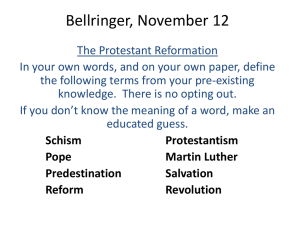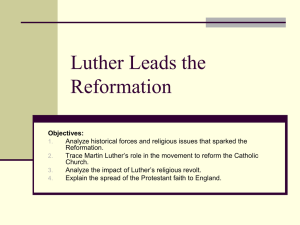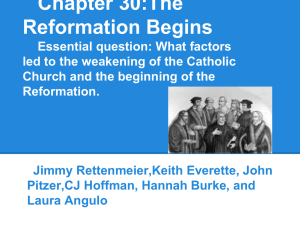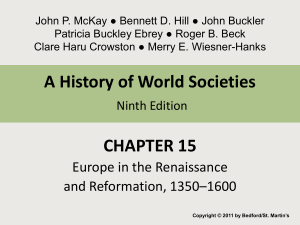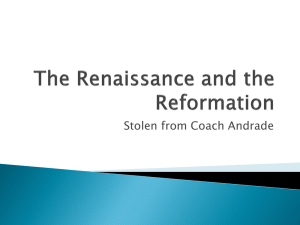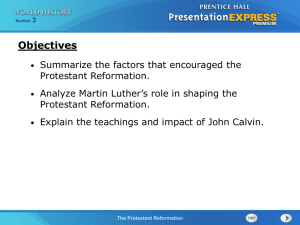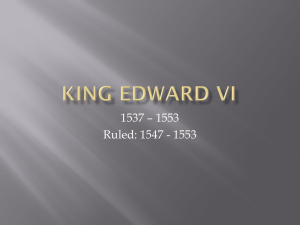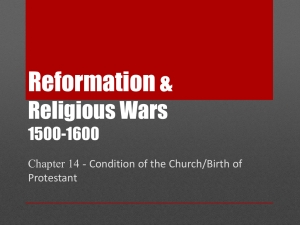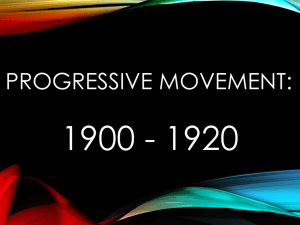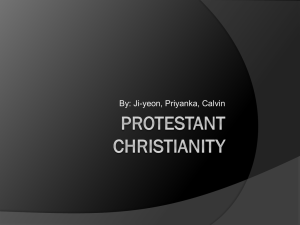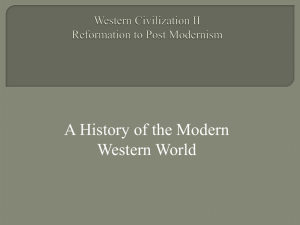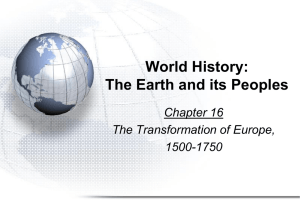The Protestant Reformation
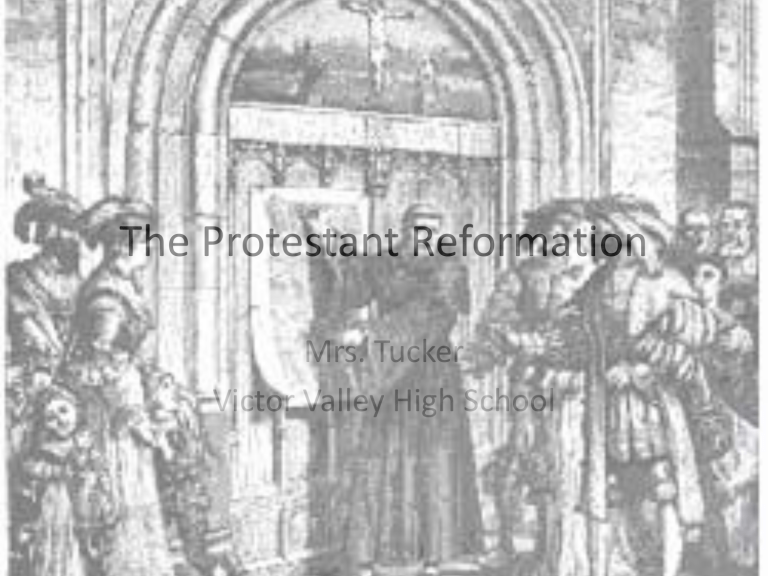
The Protestant Reformation
Mrs. Tucker
Victor Valley High School
Main Points
• The social and religious
origins of the Reformation.
• Martin Luther’s role in the
German Reformation.
• The course of the
Reformation in
Switzerland, France, and
England.
• The Catholic Counter-
Reformation’s achievements.
• The social impact of the
Reformation in western and central Europe
The Spread of the Printing Press
Society and Religion
• The Protestant Reformation grew out of concerns about matters of faith, of course, but it also had roots in political, social, and economic concerns that were pervasive in Europe.
• The emergence of centralizing national governments was challenging local custom and authority through much of Europe; in Germany and Switzerland, the free imperial cities were important early hotbeds of Protestantism.
• Often, groups (such as guilds) or regions in which people felt pushed around by authority figures were particularly receptive to Protestantism.
• Lay people were gaining power to criticize, and attempt to reform, the church, both because lay people were gaining cultural authority in general and because the church's crises had cost it so much credibility.
• The benefice system, the sale of indulgences, and the clergy's immunities of place and of person had fed secular grievances against the church.
Why the German
States?
The Holy
Roman
Empire
16
th
Century
Martin Luther
• Martin Luther, like many other Germans, was concerned about the church's sale of indulgences and other financial and political arrangements.
• Luther also had profound misgivings about the gap between human sinfulness and the righteousness required for salvation.
• An ordained priest with a doctorate in theology, he developed the doctrine of justification by faith alone, which offers salvation to believers in Christ.
• In 1517, Luther posted 95 theses against indulgence to the door of a church in
Wittenberg, thereby sparking the
Reformation.
• In the following years, Luther developed and publicized his theology; he was excommunicated in 1521.
• German humanists, peasants, and others supported Luther and his ideas, though in the peasant revolt of 1524-1525 Luther urged princes to suppress the peasants.
The Spread of Lutheranism
The Peasant Revolt 1525
Elsewhere
• In Switzerland, France, and elsewhere in
Europe, variations of Protestantism developed.
• In the 1520s, Ulrich Zwingli orchestrated the
Swiss Reformation, from his post as the people's priest in the main church of Zurich.
• Zwingli believed a literal reading of Scripture should guide Christian beliefs and practices.
• More radical groups emerged, including
Anabaptists, who believed baptism should only be performed on adults, who were capable of choosing their religion.
• John Calvin and his followers wanted to transform society morally, starting in Geneva in 1540.
• In the second half of the 16th century,
Calvinism displaces Lutheranism as Europe's dominant form of Protestantism.
Spread of Calvinism
Spread of Protestant Churches in 16
th
Century - France
Consolidation
• Between 1530 and 1552, emperor Charles V made repeated attempts to persuade or force Protestants to revert to
Catholicism.
• The 1555 Peace of Augsburg formalized Lutheranism's official status in the empire.
• Lutheranism also became the official state religion in Denmark and Sweden.
• Calvinists and Anabaptists, among others, were still excluded from official recognition throughout Europe.
Spread of Anabaptists
English
• King Henry VIII's messy marital history had dramatic consequences for England's religion: because Henry wanted to marry
Anne Boleyn, and because Pope Clement VII would (and could!) not annul Henry's marriage to Catherine of Aragon, Parliament decreed that the king, not the pope, was the
"supreme head in earth of the Church of
England.”
• Ironically, by the 1530s, many of Henry's subjects were far more sympathetic to
Protestantism than the king himself was;
Henry's Church of England differed little from the Catholic church.
• Only under the reign of his son, Edward VI, was Protestantism really instituted in
England.
• And the change in state religion did not help
Henry's personal life; he married six times before he died in 1547.
Henry VIII and Catherine of Aragon
Anne Boleyn and Jane Seymour
Anne of Cleves and Catherine Howard
Catherine Parr and Thomas Seymour
Family of Henry VIII – Allegory of Tudor
Succession
Edward VI and Lady Jane Grey
Mary I and Elizabeth I
Thomas More and Thomas Cromwell
Thomas Cranmer and John Fisher
Catholic Reform
• Protestants were not the only critics of the
Catholic church.
• Although the popes resisted reform, many new, reform-oriented orders were established in the 16th century.
• Ignatius of Loyola founded what became one of the most significant of these orders, the
Jesuits, who stressed a powerful combination of discipline and traditional spirituality.
• Between 1545 and 1563 -- with frequent interruptions for wars, plagues, papal successions, and other events – a council of the church met at Trent to reassert Catholic doctrine.
• As a result of the Council of Trent, internal church discipline was reformed, but doctrine became if anything even more strongly traditional and Scholastic in orientation.
• Improvements in the education and behavior of local clergy helped revive parish life.
Social Significance
• While the Reformation was politically conservative, it revolutionized religious practice and institutions in part of Europe.
• In cities that became Protestant, many aspects of everyday life were transformed.
• The numbers of clergy in Protestant cities declined by two-thirds, at least one-third of all churches were closed, there were onethird fewer religious holidays, and most cloisters were closed.
• Some changes did not endure: more than half the original converts to Protestantism returned to the Catholic church by the end of the 16th century.
• Protestants and the Counter-Reformation both altered education.
• Protestant reformers helped disseminate humanist learning and culture.
• The ideal of the companionate marriage and other Protestant views helped improve, though only slightly, the status of women.
Family Life
• Marriage occurred at a later age (mid- to late-twenties for men, early to mid-twenties for women) in the 16th-18th centuries than it had previously in Europe and England.
• One reason for this shift was that, in a time of population growth, it took couples longer to accumulate the capital needed to raise a family.
• Parents were generally involved in arranging their children's marriages, though the couple's own wishes also carried significant weight.
• Generally, two to four children survived to adulthood in the European nuclear family.
• Birth control was not very effective; wetnursing was controversial.
• Though they sometimes exhibited it in ways that may seem strange to us, early modern parents almost certainly loved their children, and probably also each other.
Literary Imagination
• Miguel de Cervantes Saavedra and
William Shakespeare are among the most renowned authors of this period.
• Cervantes lived and worked in
Catholic Spain, while Shakespeare was a product of Protestant England.
• Their writings reflect their very different situations and interests.
• Cervantes' most famous work, Don
Quixote, pays homage to the tradition of chivalric romance.
• Shakespeare's dramas cover a wide range of topics, including history; his universal themes and brilliant technique explain his enduring popularity.
Late 16
th
Century Protestant Europe
Conclusion
• Martin Luther's 95 Theses inaugurated the
Protestant Reformation, which altered religion and society throughout Europe.
• Soon, not just Lutheranism, but also
Calvinism and other Protestant sects were winning converts and challenging the
Catholic church.
• Catholics, meanwhile, were critiquing their church from within, and some of them were founding new orders, in part to encourage reform from within.
• The Counter-Reformation brought many
Europeans back to the Catholic church, but religious unity in Europe was a thing of the past.
• Developments in family life and in literature reflect some of the competing influences on early modern society.
Essay Question
•
Evaluate the influence of Renaissance humanism on Catholic reforms and the
Protestant Reformation.
•
2007 AP Exam, Free
Response Essay;
Grading Rubric
•
•
•
•
•
•
•
•
•
•
•
•
•
•
8–9 Points
• Explicit thesis responds fully to all prompts: humanism, Catholic reforms, and the Protestant Reformation.
• Consistently clear organization supports the argument.
• Discusses Catholic reforms and the Protestant Reformation with multiple supporting details.
• Clearly links Renaissance humanism to both Catholic reforms and the
Protestant Reformation.
• Well-balanced discussion among all prompts
. •Errors do not distract from the argument.
6–7 Points
• Explicit thesis is responsive to the question, perhaps less fully than the
8–9 category.
• Organization is clear but may not be consistently followed. •
Essay is balanced, with humanism, Catholic reforms, and the Protestant
Reformation all covered at least briefly.
• All assertions are supported by at least one piece of specific information.
•Linkage of humanism to Catholic and Protestant reforms is attempted.
• Errors may detract from the overall essay.
•
•
•
•
•
•
•
•
•
•
•
•
•
•
•
•
•
4–5 Points
• Thesis is explicit but may not respond fully to the entire question.
• Organization is less effective than in essays scored higher.
• Essay shows some imbalance. Some major topics (humanism, Catholic reforms, or the Protestant
Reformation) may be seriously neglected or have minimal specificity.
• Most of the major topics are supported by at least one relevant piece of evidence.
• Suggests linkage between humanism and Catholic/Protestant reforms.
2–3 Points
• Thesis is not explicit or merely rephrases/repeats the question. •
Unclear, ineffective organization. • Serious imbalance—major topics are neglected (e.g., discussion of the Protestant Reformation but no information on Catholic reforms). • No clear linkage between humanism and both reform movements. • Several distracting errors.
0–1 Point
• No discernable attempt at a thesis.
• No discernable organization.
• One or none of the prompts (humanism, Catholic reforms, or the
Protestant Reformation) is mentioned.
• No understanding of humanism or any linkage to Catholic/Protestant reforms
. •Little or no supporting evidence
. •Numerous errors that distract from the thesis.
Review Questions
7.
8.
9.
10.
11.
12.
13.
5.
6.
1.
2.
3.
4.
What is an indulgence? How did it become a major reform issue by the late 15 c ?
What aspects of Luther's personality and experience contributed to his reforming zeal?
What was Luther's core theological premise? Make a list of his major ideas.
How did the church initially react to the printing and dissemination of
Luther's 95 Theses in Wittenberg? Why did they have such a strong appeal in Germany?
Luther and Erasmus both attacked what they saw as abuses and pretensions of the church and the clergy. Compare their criticisms and their approaches to Church reform.
Although there had been heretics and reformers in the Catholic Church before Martin Luther, none had threatened the unity of the church. What were the social, economic, and political conditions in
Germany that contributed to the enormous success of Lutheranism?
What were the religious and political implications of Luther's reforms?
Why did the Holy Roman Empire, Charles V, in collaboration with the
Pope, issue the Edict of Worms in 1521? What were the implications of this move?
Why did many German political authorities [especially the nobility] support Luther's cause? Why was their support so essential to his success?
What were the causes of the Peasants' Revolt of 1525-1526? What was
Luther's position in this upheaval? Why did he take that position?
Where was Lutheranism most successful in the 16 c ?
What role did the Holy Roman Emperor, Charles V, play in the
Protestant Reformation?
What were the provisions of the Peace of Augsburg of 1555? How was it a religious compromise? What issues were left unresolved?
Review Questions #2
1.
2.
3.
4.
5.
6.
7.
8.
9.
10.
Identify the main religious beliefs of Ulrich Zwingli. How were they similar to Luther's beliefs? How were they different?
What were the basic beliefs of the Anabaptists? Why do you think that they were labeled the "radicals" of the
Protestant Reformation movement?
Who were the Melchiorites? Why were they so intensely persecuted?
List the major beliefs of John Calvin. How were they similar to Luther's beliefs? How were they different?
What was life like in Calvin's Geneva under his
Ecclesiastical Ordinances?
To where did Calvinism spread throughout the 16 c ?
What impact did Reformation doctrines have on the family, education, and popular religious practices?
How did the role of women in some Protestant churches change in the 16 c ? Why did their social and religious positions remain the same in most others?
According to most Reformation thinkers, what was the most important role of a woman in the Christian household?
What groups in European society were most attracted to
Calvinism? Why?
Review Questions #3
1.
How did Henry VIII's marital difficulties lead to a break with Rome and the creation of an independent Church of
England?
2.
What did Henry VIII do to the property of the Catholic Church once he was excommunicated by the Pope?
3.
Who much of Catholicism was retained during Henry VIII's reign?
4.
When and how did the Church of England become more Protestant?
5.
Why did Henry VIII's break with Rome have so much support from the English people?
6.
How did Mary I attempt to restore
Catholicism in England? Why did she fail?
7.
How did the power of the British monarchy increase during the reign of the Tudors?
8.
What new political institutions/government structures were created during this period?
Review Questions #3
•
•
•
•
•
•
•
•
•
•
•
•
•
•
What were the differences in interpretation of the two terms--Catholic
Reformation and Counter-Reformation?
What were the accomplishments of Pope Paul III? of Pope Paul IV? How did they differ in their approach to church reform?
How did the responses of the church hierarchy differ from the responses of lay people?
What were the primary goals of the Council of Trent?
List the major positions taken by the Council of Trent on dogma and church reform.
What was the condition of the papacy as it emerged after the Council of
Trent?
List some of the new religious orders created during this period and briefly identify the religious mission of each.
How did Ignatius Loyola organize the Jesuit order? What was its purpose?
How did the Jesuits differ from previous Catholic religious orders?
How did Ignatius Loyola's Spiritual Exercises and the Jesuit movement itself represent a continuation of Renaissance humanism?
Why was the Jesuit order so fit to serve the Catholic Counter-Reformation?
How did women react to the Reformation and the Counter-Reformation?
What appeal would the reforming tendencies have held for women? Why do you suppose other women remained faithful to the Catholic Church?
What were the political, economic, and social legacies of the "Two
Reformations?"
Review Questions #4
•
What is the origin of the word "baroque"?
•
What was the goal of
Baroque art? What were the characteristics of the Baroque style?
•
